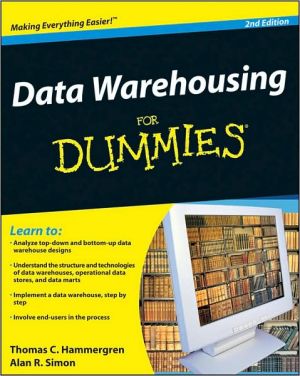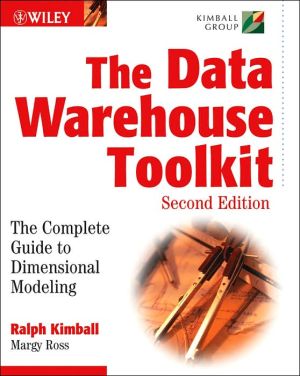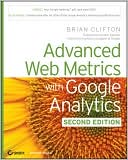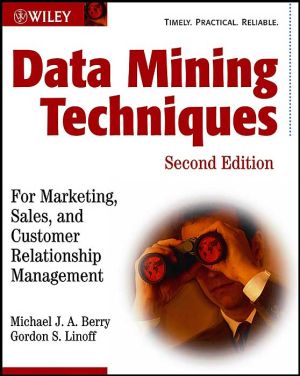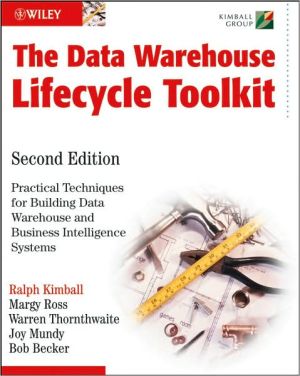Data Warehousing For Dummies
Data warehousing is one of the hottest business topics, and there’s more to understanding data warehousing technologies than you might think. Find out the basics of data warehousing and how it facilitates data mining and business intelligence with Data Warehousing For Dummies, 2nd Edition.\ Data is probably your company’s most important asset, so your data warehouse should serve your needs. The fully updated Second Edition of Data Warehousing For Dummies helps you understand, develop,...
Search in google:
There's more to data warehousing than you think, so start right here! You don't need a forklift to work with a data warehouse, but you do need a hefty load of know-how to make wise decisions when setting one up. Data is probably your company's most important asset, so your data warehouse should serve your needs. Here's how to understand, develop, implement, and use data warehouses, plus a sneak peek into their future. Know your stuff — understand what a data warehouse is, what should be housed there, and what data assets are Get a handle on technology — learn about column-wise databases, hardware assisted databases, middleware, and master data management The intelligent view — see how business intelligence and data warehousing work together Ask the right questions — explore data mining and learn to find what you need Do the groundwork — choose your project team and apply best development practices to your data warehousing projects Keep the user in mind — involve your users in defining business needs through testing, and learn how to get valuable feedback Fix or replace? — learn how to review and upgrade existing data storage to make it serve your needs Buyer beware — be prepared when dealing with data warehousing product vendors Open the book and find: What to expect from your data warehouse The difference between data warehouses and data marts All about specialty database technologies What to look for in a consultant How your data warehouse feeds dashboards and scorecards Secrets for managing a successful data warehouse project How to effectively capture business needs and requirements Ten signs your project is in trouble
Introduction.Why I Wrote This Book.How to Use This Book.PART I: The Data Warehouse: Home for Your Secondhand Data.PART II: Data Warehousing Technology.PART III: Business Intelligence and Data Warehousing: Not a Contradiction in Terms.PART IV: Data Warehousing Projects: How to Do Them Right.PART V: Data Warehousing: The Big Picture.PART VI: Data Warehousing in the Not-Too-Distant Future.PART VII: The Part of Tens.Icons Used in This Book.A Word about the Product References in This Book.PART I: The Data Warehouse: Home for your Secondhand Data.Chapter 1: What's in a Data Warehouse?The Data Warehouse: A Place for Your Used Data.More Formal Definitions.Today's data warehousing defined.A broader, forward-looking definition.A Brief History of Data Warehousing.The 1970s.The 1980s.The 1990s.Is a Bigger Data Warehouse a Better Data Warehouse?Realizing That a Data Warehouse (Usually) Has a Historical Perspective.It's Data Warehouse, Not Data Dump.Chapter 2: What Should You Expect from Your Data Warehouse?Using the Data Warehouse to Make Better Business Decisions.Finding Data at Your Fingertips.Facilitating Communications with Data Warehousing.IT-to-business-organization communications.Communications across business organizations.Facilitating Business Change with Data Warehousing.Chapter 3: Have It Your Way: The Structure of a Data Warehouse.Ensuring That Your Implementations Are Unique.Classifying the Data Warehouse.The data warehouse lite.Subject areas.Data sources.Database.Data content.Tools.Dataextraction, movement, and loading.Architecture.The data warehouse deluxe.Subject areas.Data sources.Database.Data content.Tools.Data extraction, movement, and loading.Architecture.The data warehouse supreme.Subject areas.Data sources.Database.Data content.Tools.Data extraction, movement, and loading.Architecture.Double data warehouse with cheese.To Centralize or Distribute, That Is the Question.Chapter 4: Data Marts: Your Retail Data Outlet.The Idea behind Data Marts.Architectural Approaches to Data Marts.Data marts sourced by a data warehouse.Tactical, quick-strike data marts.Bottom-up, integration-oriented data marts.What Should Be in a Data Mart.Geography-bounded data.Organization-bounded data.Function-bounded data.Competitor-bounded data.Answers to specific business questions.Anything!Implementing a Data Mart -- Quickly.PART II: Data Warehousing Technology.Chapter 5: Relational Databases and Data Warehousing.The Old Way of Thinking.A technology-based discussion: The roots of relational database technology.The OLAP-only fallacy.The New Way of Thinking.Understanding how RDBMSs were enhanced to support data warehousing.Handling the very large database (VLDB) problem -- and getting the RDBMS answer.Designing Your Relational Database for Data Warehouse Usage.Looking at why traditional relational design techniques don't work well.Explaining normalization in plain language (or trying to).The side effect of normalization.Exploring new ways to design a relational-based data warehouse.Relational Products and Data Warehousing.IBM DB2 family.Informix.Microsoft SQL Server.Oracle.Red Brick.Sybase.Chapter 6: You're Entering a New Dimension: Multidimensional Databases.The Idea behind Multidimensional Databases.Facts.Dimensions.The basics."Is there a limit to the number of dimensions?"."How should I choose the levels in a hierarchy?".Physical database structures in an MDDB.Are Multidimensional Databases Still Worth Looking At?Other Specialized Database Technology for Data Warehousing.Sybase IQ.In-memory databases: Is anything really there?Chapter 7: Stuck in the Middle with You: Data Warehousing Middleware.What Is Middleware?Middleware for Data Warehousing.The services.Should you use tools or custom code?What Each Middleware Service Does for You.Data selection and extractions.Data quality assurance (QA), Part I.Data movement, Part I.Data mapping and transformation.Data quality assurance (QA), Part II.Data movement, Part II.Data loading.Replication Services for Data Warehousing.Vendors with Middleware Products for Data Warehousing.Carleton Corporation.Evolutionary Technologies International (ETI).Informatica.Platinum Technology.Praxis International.Prism Solutions.Reliant Data Systems.Sagent Technology.VMARK.PART III: Business Intelligence and Data Warehousing.Chapter 8: An Intelligent Look at Business Intelligence.The Four Main Categories.Querying and reporting.OLAP.Data mining.Executive Information Systems (ELS).Other Types of Business Intelligence.Statistical processing.Geographical information systems.Business Intelligence Architecture and Data Warehousing.Chapter 9: Simple Database Querying and Reporting.What Functionality Does a Querying and Reporting Tool Provide?The role of SQL.The idea of managed queries and reports.Is This All You Need?Designing a Relational Database for Querying and Reporting Support.Vendors with Querying and Reporting Products for Data Warehousing.Andyne.Business Objects.Cognos Corporation.Information Builders.Microsoft Corporation.Seagate Software.Chapter 10: Online Analytical Processing (OLAP).What Is OLAP?The OLAP Acronym Parade.First, an Editorial.OLAP Features: An Overview.Drill-down.Drill-up.Drill-across.Drill-through.Drill-bit.Pivoting.Trending.Vendors with OLAP Products for Data Warehousing.Arbor Software.Brio Technology.Gentia.Information Advantage.Informix.MicroStrategy.Oracle Corporation.Seagate Software.Chapter 11: Data Mining: Hi-Ho, Hi-Ho, It's Off to Mine We Go.Data Mining without the Hype.The "Tell me what may happen" role.The "Tell me something interesting" role.Data Mining in Specific Business Missions.Haven't I Heard This Before?Data Mining and Artificial Intelligence.Data Mining and Statistics.Some Vendors with Data Mining Products.CrossZ Software.DataMind Corporation.HNC Software.IBM.NeoVista Solutions.Thinking Machines Corporation.Chapter 12: Executive Information Systems (ELS).ElS Principles.The Relationship between ElS and the Other Parts of Business Intelligence.ElS and Key Indicators.The Briefing Book.The Command Center.Who Produces EIS Products.PART IV: Data Warehousing Projects: How to Do Them Right.Chapter 13: Data Warehousing and Other IT Projects: The Same but Different.Why a Data Warehousing Project Is (Almost) Like Any Other Development Project.How to Apply Your Company's Best Development Practices to Your Project.How to Handle the Uniqueness of Secondhand Data.Why Your Data Warehousing Project Must Have Top-Level Buy-In.How Do I Conduct a Large, Enterprise-Scale Data Warehousing Initiative?Top-down.Bottom-up.Mixed-mode.Chapter 14: Building a Winning Data Warehousing Project Team.Don't Make This Mistake!The Roles You Have to Fill on Your Project.Project manager.Technical leader.Chief architect.Business requirements analyst.Data modeler and conceptual/logical database designer.Database administrator and physical database designer.Front-end tools specialist and developer.Middleware specialist.Quality assurance (QA) specialist.Source data analyst.User community interaction manager.Technical executive sponsor.User community executive sponsor.And Now, the People.Chapter 15: Analyzing Data Sources.Begin with Source Data Structures, but Don't Stop There.Identify What Data You Need to Analyze.Line Up the Help You'll Need.Techniques for Analyzing Data Sources and Their Content.Analyze What's Not There: Data Gap Analysis.Determine Mapping and Transformation Logic.Chapter 16: User Testing, Feedback, and Acceptance.Recognizing That Early User Involvement Is Critical to Data Warehousing Success.Using Real Business Situations.Ensuring That Users Provide Necessary Feedback.After the Scope: Involving Users during Design and Development.Understanding What Determines User Acceptance.PART V: Data Warehousing: The Big Picture.Chapter 17: Dealing with External Data.Identifying Data You Need from Other People.Recognizing Why External Data Is Important.Viewing External Data from a User's Perspective.Determining What External Data You Really Need.Ensuring the Quality of Incoming External Data.Filtering and Reorganizing Data after It Arrives.Restocking Your External Data.Acquiring External Data.Finding this type of information.Gathering general information.Cruising the Internet.Maintaining Control over External Data.Staying on Top of Changes.Knowing What to Do with Historical External Data.Determining When New External Data Sources Are Available.Switching from One External Data Provider to Another.Chapter 18: Data Warehousing and the Rest of Your Information Systems.A Data Warehouse Does Not Stand Alone.The Infrastructure Challenge.Strategic Initiatives: Watch Out!Internal Standards and How They Affect Your Data Warehousing Environment.Dealing with Conflict: Special Challenges to Your Data Warehousing Environment.Chapter 19: The View from the Executive Boardroom.What Does Top Management Need to Know?Tell them this.Keep selling the data warehousing project.Data Warehousing and the Business Trends Bandwagon.Data Warehousing in a Cross-Company Setting.Chapter 20: Surviving in the Computer Industry (and Handling Vendors).Help -- I'm Up to My Armpits in Hype!How to Be a Smart Shopper at Conferences and Trade Shows.Do your homework first.Ask lots of questions.Be skeptical.Don't get rushed into a purchase.Dealing with Data Warehousing Product Vendors.Check out the product and the company before you begin discussions.Take the lead during the meeting.Be skeptical -- again.Be a cautious buyer.A Look Ahead: Mainstream Technologies and Vendors.Chapter 21: Existing Sort-of Data Warehouses: Upgrade or Replace?What's Out There?The first step: Cataloguing the extract files, who uses them, and why.And then, the review.Decisions, Decisions.Choice 1: Get rid of it.Choice 2: Replace it.Choice 3: Retain it.Caution: Migration Is Not Development -- It's Much More Difficult.Beware: Don't Take Away Valued Functionality.Chapter 22: Working with Data Warehousing Consultants.Do You Really Need Consultants to Help Build a Data Warehouse?Watch Out, Though!A Final Word about Data Warehousing Consultants.PART VI: Data Warehousing in the Not-too-Distant Future.Chapter 23: The Operational Data Store (I" Need Information Now!").The ODS Defined.An ODS Example.The complications.The ODS solution.ODS Architectural Challenges.The basics: Warehouse-enabled applications.Messaging.Feedback loops.Data message hubs.Chapter 24: Show Me the Pictures: Incorporating Multimedia.Traditional Data Warehousing Means Analyzing Traditional Data Types."It's a Multimedia World, after All…".How Will Multimedia Business Intelligence Work?An Alternative Path: From Unstructured Information to Structured Data.Chapter 25: Virtual Data Warehousing: Hype or Trend?Looking at the Basics of Virtual Data Warehousing.Background.Market repositioning.Challenges.Examining Why Traditional Virtual Data Warehousing Doesn't Work.The architecture.The synthesis service.Other services.Facing the Infrastructure Challenge.Making Virtual Data Warehousing a Reality in Your Organization.PART VII: The Part of Tens.Chapter 26: Ten Vital "Deliverables" for the End of Your Project Scope.A Complete, Prioritized List of Functionality to Be Provided.A Complete List of All Candidate Data Sources.A Design-Phase Project Plan.The Names and Respective Roles of Your Design-Phase Project Team.A Complete Budgetary Estimate.Consensus about the Mission.Risk Assessment and a Plan to Manage Risk.A Gap Analysis.Tentative Executive-Level Support.Logistical Requirements and Support Plans.Chapter 27: Ten Questions to Consider When You're Selecting User Tools.Can Users Easily Build Their Own Query and Report Screens?Can a User Stop a Runaway Query or Report?How Does Performance Differ with Varying Amounts of Data?Can Users Access Different Databases?Can Data Definitions Be Easily Changed?Does the Tool Fit into Your Organization's Standard Desktop Configuration?How Does Performance Change with a Large Number of Users?What Online Help and Assistance Is Available, and How Good Is It?Does the Tool Support Interfaces to Other Products?What Happens When You Pull the Plug?Chapter 28: Ten Secrets to Managing a Project Successfully.Tell It Like It Is.Put the Right People in the Right Roles.Be a Tough but Fair Negotiator.Deal Carefully with Product Vendors.Watch the Project Plan.Don't Micromanage.Use a Project Notebook.Don't Overlook the Effect of Organizational Culture.Don't Forget about Deployment and Operations.Take a Breather Occasionally.Chapter 29: Ten Sources of Up-to-Date Information about Data Warehousing.The Data Warehousing Institute.The Data Warehousing Information Center.The OLAP Report.Datamation.data-warehouse.com.Data Warehousing on the World Wide Web.The International Data Warehousing Association.Industry Analysts' Web Sites.Cambridge Technology Partners.Product Vendors' Web Sites.Chapter 30: Ten Mandatory Skills for a Data Warehousing Consultant.Broad Vision.Deep Technical Expertise in One or Two Areas.Communications Skills.The Ability to Analyze Data Sources.The Ability to Distinguish between Requirements and Wishes.Conflict-Resolution Skills.An Early-Warning System.General Systems and Application Development Knowledge.The Know-How to Find Up-to-Date Information.A Hypefree Vocabulary.Chapter 31: Ten Signs of a Data Warehousing Project in Trouble.The Project's Scope Phase Ends with No General Consensus.The Mission Statement Gets Questioned after the Scope Phase Ends.Tools Are Selected without Adequate Research.People Get Pulled from Your Team for "Just a Few Days".You're Overruled When You Attempt to Handle Scope Creep.Your Executive Sponsor Leaves the Company.You Overhear, "This Will Never Work, but I'm Not Saying Anything".You Find a Major "Uh-Oh" in One of the Products You're Using.The IT Organization Responsible for Supporting the Project Pulls Its Support.Resignations Begin.Chapter 32: Ten Signs of a Successful Data Warehousing Project.The Executive Sponsor Says, "This Thing Works -- It Really Works!".You Receive a Flood of Suggested Enhancements and Additional Capabilities.User Group Meetings Are Almost Full.The User Base Keeps Growing and Growing and Growing.The Executive Sponsor Cheerfully Volunteers Your Company As a Reference Site.The Company CEO Asks, "How Can I Get One of Those Things?".The Response to Your Next Funding Request Is "Whatever You Need -- It's Yours".You Get Promoted -- and So Do Some of Your Team Members.You Achieve Celebrity Status in the Company.You Get Your Picture on the Cover of Rolling Stone.Chapter 33: Ten Subject Areas to Cover with Product Vendors.The Product's Chief Architect.The Development Team.Customer Feedback.Employee Retention.The Marketplace.Product Uniqueness.Clients.The Future.Internet Approach.Integrity.Index.Book Registration Information.
